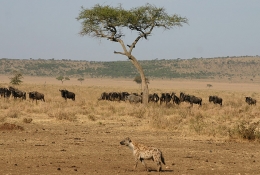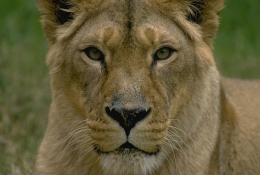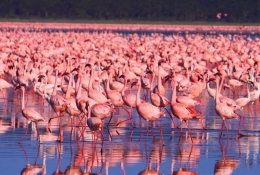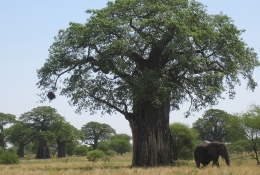
Serengeti National Park
A million wildebeest”¦ each one driven by the same ancient rhythm, fulfilling its instinctive role in the inescapable cycle of life
Location:
The 14,763 km2park is the second largest park in Tanzania after Selous National Park. The park is located near the Kenyan border besides Masai Mara National Reserve. In fact, the Serengeti National Park shares border with the Masai Mara National Reserve. Its location is on the North eastern side of Tanzania.
Attractions:
Serengeti is perhaps most well known for the annual migration that takes place across the great Savannah plains. This is a phenomenal sight: thousands upon thousands of animals, particularly wildebeests, as far as the eye can see. During the rainy season (from November to May), the wildebeests, whose population has been estimated at around 1’500’000, are found in the eastern section of the Serengeti and also the Masai Mara in Kenya to the north. When the dry season begins at the end of June, the annual migration commences as the animals move in search of food pasture. The Serengeti is also famous for cheetahs, leopards and lions, some of which migrate with the wildebeests while others remain in the central plain.
The elephant population in Serengeti was decimated by poaching, estimated to have fallen fivefold during the 1970 — 80s, since then, the numbers have slowly increased. Birdlife is prolific in the National Park and includes various species of kingfishers, sunbirds and rollers, ostriches, egrets, herons, storks, ibises, spoonbills and ducks. Birds of prey include Ruppell’s vulture and the hooded vulture, several varieties of kestrels, eagles, goshawks and harriers. There is also a hippo pool by the name of Retina where you can have clear views of the hippopotamuses and even crocodiles.
How to get there:
Air: There are several airstrips inside the park. There are return scheduled flights to Seronera and Grumeti River Camp and also to Lobo Wildlife Lodge and Klein’s Camp on specific days. There is also a return flight from Dar es Salaam via Zanzibar which usually takes 2 hours one way.
Road: Serengeti is usually approached from Arusha along a fairly good road. From Arusha, you will pass the entrance to Lake Manyara National Park and through Ngorongoro Conservation Area.
Approaching form Mwanza or Musoma on the lake shore, take the road east and you will enter the Serengeti through the Ndaraka Gate in the West..










